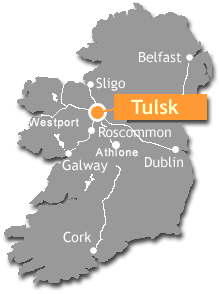Ráth na dTarbh, translating as 'the fort of the bulls' is one of the most interesting sites within the complex of Rathcroghan. The name was first recorded in 1837 by the now familiar John O'Donovan of the Ordnance Survey.
Rathnadarve, sketched by H.T. Knox in 1911, was described in the same publication as 'an ordinary rath which encloses an oval esker'. It measures about 115m, making it a rather large example of a ringfort. It is of univallate or single bank and ditch construction and can be seen clearly in the external ditch and internal bank running the entire circumference of the monument. The bank, where it is best preserved, averages 6m in width and 2.25m in height. The ditch averages 5m in width and 50cm in height, although the ditch would have been substantially deeper during its period of use.
 |
| Rathnadarve (Image courtesy of M. Casey) |
In its present state, access to its interior is served by seven gaps in the bank, however, not all of these gaps would have represented an entrance. These breaks in the bank are from centuries of cattle grazing disturbing the monument. The most likely candidate for the entrance to the site is visible SSE of the monument, where the gap in question is 6m wide with some physical traces of a possible causeway evident. Immediately to the south of this 'entrance' is a small body of water, that has been tentatively suggested as a ritual pool.
The various geophysical techniques that have been used to analyse the monument have turned up some anomalies that suggest settlement. These include the presence of possible burning activities on the summit of the internal mound and a possible 8m structure in the north of the interior. Excavation would be required to gain a more accurate understanding of the features on the monument.
 |
| 3D LiDAR model of Rathnadarve (OSi & Kevin Barton) |
Aside from the archaeology, folkloric tradition locates Rathnadarve as the place where the Finnbennach and Donn Cúailnge, the two bulls at the centre of the great epic Táin Bó Cúailnge, met in mortal combat. This heavyweight bout took place at the very end of the story, a final battle after the men of Ireland had fought each other to a standstill. The tale describes them fighting night and day until eventually the Donn Cúailnge finally impaled his adversary on his horns, taking parts of the Finnbennach's carcass away with him as he headed back to his home at the foot of the Cooley Mountains.
 |
| Desmond Kinney's mosaic of the Táin |
In fact, when standing on the banks that enclose the raised central space on Rathnadarve, it is not too far a stretch of imagination in order to see the two monstrous bulls of Irish myth engaged in a fight to the death. The possible ceremonial use of this monument, with raised interior, could be the perfect platform from which to address an Iron Age assembly. The 'ritual' pool would links this monument into the ceremonial and ritual use mentioned. It could be surmised that the pool was in fact a point of votive offering or 'sacrifice' into watery depths which is seen across the Celtic world as a means of appeasing the gods. Daniel Curley
 |
| Rathnadarve is located slightly to the west of centre in this map, with Rathcroghan Mound in sight close by. |



No comments:
Post a Comment